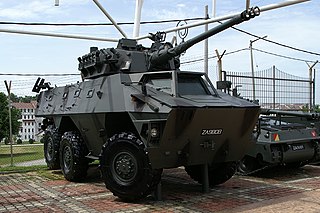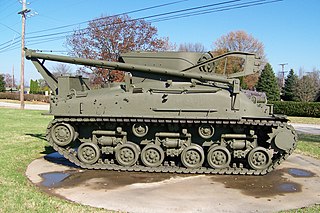
An armoured fighting vehicle or armored fighting vehicle (AFV) is an armed combat vehicle protected by armour, generally combining operational mobility with offensive and defensive capabilities. AFVs can be wheeled or tracked. Examples of AFVs are tanks, armoured cars, assault guns, self-propelled artilleries, infantry fighting vehicles (IFV), and armoured personnel carriers (APC).

A military engineering vehicle is a vehicle built for construction work or for the transportation of combat engineers on the battlefield. These vehicles may be modified civilian equipment or purpose-built military vehicles. The first appearance of such vehicles coincided with the appearance of the first tanks, these vehicles were modified Mark V tanks for bridging and mine clearance. Modern military engineering vehicles are expected to fulfill numerous roles, as such they undertake numerous forms, examples of roles include; bulldozers, cranes, graders, excavators, dump trucks, breaching vehicles, bridging vehicles, military ferries, amphibious crossing vehicles, and combat engineer section carriers.

The Centurion was the primary British Army main battle tank of the post-World War II period. Introduced in 1945, it is widely considered to be one of the most successful post-war tank designs, remaining in production into the 1960s, and seeing combat into the 1980s. The chassis was adapted for several other roles, and these variants have remained in service. It was a very popular tank with good armour, mobility, and a powerful main armament.

The Mowag Piranha is a family of armoured fighting vehicles designed by the Swiss company Mowag.

A tow truck is a truck used to move disabled, improperly parked, impounded, or otherwise indisposed motor vehicles. This may involve recovering a vehicle damaged in an accident, returning one to a drivable surface in a mishap or inclement weather, or towing or transporting one via flatbed to a repair shop or other location.

The FV180 Combat Engineer Tractor or C.E.T. is an amphibious specialist armoured vehicle formerly used by the British Army. A tracked, lightly armoured vehicle, with amphibious capability, the CET was used by Royal Engineers in ground preparation for bridge construction and towing activities in the front line of battle, such as digging vehicle fighting pits, constructing earthen barriers, repairing roads, recovery of disabled vehicles from water and other obstacles, preparing riverbanks for vehicle crossings and clearing obstacles.

An armoured recovery vehicle (ARV) is typically a powerful tank or armoured personnel carrier (APC) chassis modified for use during combat for military vehicle recovery (towing) or repair of battle-damaged, stuck, and/or inoperable armoured fighting vehicles, such as tanks and armoured personnel carriers. Most ARVs have motorized tracks, like a tank or bulldozer, enabling the ARV to operate on uneven ground. The term "Armoured Repair and Recovery Vehicle" (ARRV) is also used.

The M19 Tank Transporter was a heavy tank transporter system used in World War II and into the 1950s. It consisted of a 12-ton 6×4 M20 Diamond T Model 980 truck and companion 12-wheel M9 trailer.

The United States provided tens of thousands of its Medium Tank M4, also named the Sherman, to many of its Allies during the Second World War, under the terms of Lend-Lease.

The M88 Recovery Vehicle is one of the largest armored recovery vehicles (ARV) in use by United States Armed Forces. There are three variants, the M88, the M88A1, and the M88A2 HERCULES. The M88 series has seen action in the Vietnam War, the Persian Gulf War, the Iraq War, and the War in Afghanistan, and to a lesser extent during the Kosovo War, where they were deployed to help recover heavy armored vehicles of the Allied ground units. As of 2000, the M88A2 replacement cost was around US$2,050,000.

Armoured Vehicle Royal Engineers (AVRE), also known as Assault Vehicle Royal Engineers, is the title given to a series of armoured military engineering vehicles operated by the Royal Engineers (RE) for the purpose of protecting engineers during frontline battlefield operations.

The Scammell Pioneer was a British 6×4 tractor unit used in World War II as an artillery tractor, recovery vehicle and tank transporter.

A tank transporter is a combination of a heavy tractor unit or a ballast tractor and a mating full trailer, hydraulic modular trailer or semi-trailer, used for transporting tanks and other armoured fighting vehicles. Some also function as tank recovery vehicles, the tractors of which may be armoured for protection in combat conditions.

An armoured personnel carrier (APC) is a broad type of armoured military vehicle designed to transport personnel and equipment in combat zones. Since World War I, APCs have become a very common piece of military equipment around the world.

The FV434 is the Armoured Repair Vehicle variant of the British Army's FV430 series of armoured fighting vehicles. Introduced in the 1960s primarily as a means of quickly changing Chieftain MBT power packs in the field, it is operated by the Royal Electrical and Mechanical Engineers (REME). It is still used by the REME.

The Norinco Type 77 is a Chinese amphibious armoured personnel carrier. First fielded in 1978, it is similar to the Soviet BTR-50 in function. Like the BTR-50 designed by putting a higher hull on the PT-76 light tank chassis, Type 77 is based on the Type 63 light tank, which is itself a derivative of PT-76, making both vehicles very similar.

The SIBMAS is a Belgian amphibious infantry fighting vehicle. It was engineered from the same prototype as the South African Ratel. In appearance the vehicle is also similar to the Chinese WZ-523 armoured personnel carrier. The SIBMAS was developed between 1975 and 1976 at a department of the BN Constructions Ferroviaires et Metalliques in Nivelles. Production was on an order-by-order basis and commenced only for the Malaysian Army.

The history and development of tanks in the Royal Canadian Armoured Corps can be broken down into smaller categories: their origin during World War I; the interwar period; World War II; the Cold War; and the modern era.

The M32 Armored Recovery Vehicle was an armored recovery vehicle (ARV) used during World War II and the Korean War by the United States, and was based on the chassis of the M4 Sherman medium tank. During World War II, the British also used several hundred M32s, which were obtained through Lend-Lease in 1944. The first four prototypes were produced in January 1943, labeled T5, T5E1, T5E2, T5E3, and T5E4. After a series of tests at the Aberdeen Proving Grounds, the prototypes were approved as M32, M32E1, M32E2, M32E3, and M32E4. However, the M32E4 never entered production. There were also variants that had Horizontal Volute Spring Suspension (HVSS), which were demarcated by the suffix "A1" after the model number.

The Challenger Armoured Repair and Recovery Vehicle or CRARRV is a large British armoured recovery vehicle based on the hull of the Challenger 1 main battle tank. The CRARRV is currently operated in conjunction with the Challenger 2 tanks of the British Army and Royal Army of Oman. It is one of the few vehicles capable of repairing and recovering Challenger tanks in the field. Eighty vehicles were delivered to the British between 1988 and 1993; an additional four vehicles were delivered to Oman.


















